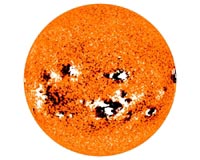 |
Redondo Beach CA (SPX) May 22, 2009 Northrop Grumman was awarded a contract by NASA Langley Research Center to build a sensor that measures the time and space distributions of incoming energy from the sun and outgoing thermal and reflected energy from Earth (known as Earth's radiation budget). The sensor will be integrated onto the first National Polar-orbiting Operational Environmental Satellite System (NPOESS) spacecraft. The Clouds and the Earth's Radiant Energy System (CERES) sensor is the seventh in the line built by Northrop Grumman at its Redondo Beach, Calif., space systems manufacturing facility. The unit will be developed using many existing parts, creating a cost effective and low risk solution to extending these important climate measurements. "CERES Flight Model 6 will extend continuous, precise, calibrated global measurements of the earth's radiation budget over nearly three decades to 2020," said Mark Folkman, director of Civil Sensor Systems for Northrop Grumman Aerospace Systems sector. "Our work with NASA Langley Research Center and the science community is creating a very valuable long-term record for climate scientists." The CERES sensors measure the Earth's radiation balance, which is a critical part of the climate system and is directly influenced by changes in greenhouse gases and aerosols, cloud properties, and surface and atmospheric temperature. The CERES sensors are broadly acknowledged as the most accurate broadband climate sensors ever flown in space. This sensor and an earlier generation of similar sensors also built by Northrop Grumman, called Earth Radiation Budget Experiment, have been capturing measurements of the reflected solar radiation and emitted thermal radiation over the Earth's surface since 1984. Four CERES sensors are currently operational on NASA's Terra and Aqua Earth Observing Systems. Another unit has been delivered and integrated onto the NPOESS Preparatory Project and one unit completed its mission aboard the Tropical Rainfall Measuring Mission. Share This Article With Planet Earth
Related Links Clouds and the Earth's Radiant Energy System (CERES) Solar Science News at SpaceDaily
 NOAA Predicts Mild Solar Storm Season
NOAA Predicts Mild Solar Storm SeasonWashington DC (SPX) May 11, 2009 Although its peak is still four years away, a new active period of Earth-threatening solar storms will be the weakest since 1928, predicts an international panel of experts led by NOAA's Space Weather Prediction Center and funded by NASA. Despite the prediction, Earth is still vulnerable to a severe solar storm. Solar storms are eruptions of energy and matter that escape from the sun and ... read more |
|
| The content herein, unless otherwise known to be public domain, are Copyright 1995-2009 - SpaceDaily. AFP and UPI Wire Stories are copyright Agence France-Presse and United Press International. ESA Portal Reports are copyright European Space Agency. All NASA sourced material is public domain. Additional copyrights may apply in whole or part to other bona fide parties. Advertising does not imply endorsement,agreement or approval of any opinions, statements or information provided by SpaceDaily on any Web page published or hosted by SpaceDaily. Privacy Statement |